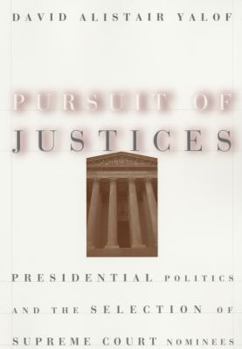Pursuit of Justices
Select Format
Select Condition 
Book Overview
Although the Senate confirmation of Supreme Court nominees is the most public part of the nomination process, the most critical phase--the initial selection of nominees--is usually hidden from view. In Pursuit of Justices, David Yalof takes the reader behind the scenes of what happens before the Senate hearings to show how presidents go about deciding who will sit on the highest court in the land. As Yalof shows, an intricate web of forces--competing factions within the executive branch, organized interests, and the president's close associates--all vie for influence during this phase of presidential decisionmaking. Yalof draws on the papers of seven modern presidents, from Truman to Reagan, and firsthand interviews with key figures, such as Ramsey Clark, Edwin Meese, and President Gerald Ford. He documents and analyzes the selection criteria these presidents used, the pool of candidates from which they chose, their strategies, and the political pressures affecting their decisions, both successes and failures. Yalof also disputes much conventional wisdom about the selection process, including the widely held view that presidents choose nominees primarily to influence future decisions of the high court. In a substantial epilogue, Yalof offers insightful observations about the selections of Presidents George Bush and Bill Clinton. By focusing on a neglected area of presidential politics, Yalof offers a fascinating and unprecedented glimpse into the intricate world of executive branch decisionmaking and the Supreme Court appointment process as a whole.
Winner of the 2000 Richard E. Neustadt Award for Best Book on the American Presidency
Winner of the 2000 Richard E. Neustadt Award for Best Book on the American Presidency
Format:Paperback
Language:English
ISBN:0226945464
ISBN13:9780226945460
Release Date:December 2001
Publisher:University of Chicago Press
Length:312 Pages
Weight:0.95 lbs.
Dimensions:0.7" x 6.0" x 9.0"
Customer Reviews
5 ratings
A tremendous job
Published by Thriftbooks.com User , 21 years ago
Yalof has done a tremendous job on a very important subject, the process by which presidents select their Supreme Court nominees. He identifies the most widely used presidential approaches to the selection process, as well as isolating ten factors that have changed the modern day selection process.Yalof then applies these broad factors to each of the nominations made to the Supreme Court since the Truman Administration. Of particular interest is his coverage of the Reagan nominees, especially Judge Bork.Yalof's book would be a great one for an introductory class about the Supreme Court. Using tons of primary source material, it is a fascinating look into how and why presidents choose the Supreme Court nominees they do.
A book whose time is coming (again)
Published by Thriftbooks.com User , 22 years ago
This fascinating and well-written piece will soon grace the desk of journalists and decisionmakers everywhere, as new spots inevitably open up on the nation's highest bench. Yalof's first work is a triumph of scholarship, storytelling, and insight.
Liberty and Property in the Hands of Nine Unknown Persons
Published by Thriftbooks.com User , 24 years ago
I reviewed Yalof's Pursuit of Justices for the New York Law Journal (December 10, 1999). He describes how nominees for the Supreme Court were chosen during the Truman through Reagan presidencies. His subject is novel, painstakingly examined and offered in a sustained, highly readable prose. His book deserves shelf space in libraries public and private. Its harvest of facts catches and holds one's attention, and is so full that no review can do its details justice. Of the seven presidencies, those covering Nixon and Reagan should be read first for sheer enjoyment at the sight of a driven nomination process in high gear. The seventh chapter, an exposition of the forms and problems in nominee selection, is in itself a handbook that should be kept in the right hand drawer of a President's desk, its copies to be distributed among those humble Machiavellians who even now are laying long-term plans for their nominations. If you want to keep awake at night, read Yalof's description of how Nixon toyed with the idea of "sticking it" to the Democrats by nominating Senator Robert Byrd who had obtained his law degree while in the Senate and had never practiced law, and if that doesn't do it, try Nixon's consideration of vice president Spiro Agnew for appointment to the court.
Liberty and Property in the Hands of Nine Unknown Persons
Published by Thriftbooks.com User , 24 years ago
I wrote the review of Yalof's Pursuit of Justices for the New York Law Journal (December 10, 1999). Yalof describes how nominees for the Supreme Court were chosen during the Truman through Reagan pesidencies. His subject is novel, painstakingly examined and offered in a sustained, readable prose. His book deserves shelf space in libraries public and private. Its harvest of facts catches and holds one's attention, and is so full that no review can do its details justice. Of the seven presidencies, those covering Nixon and Reagan should be read first for sheer enjoyment at the site of a driven nomination process in high gear. The seventh chapter, an exposition of the forms and problems in nominee selection, is in itself a handbook that should be kept in the right hand drawer of a President's desk, its copies to be distributed among those humble Machiavellians who even now are laying long-term plans for their nominations.
A good history of the Supreme Court selection process
Published by Thriftbooks.com User , 25 years ago
This book details the selection process of Supreme Court nominees from 1945 to the present. The book focuses on the President and his decision process in selecting nominees. While there is solid analysis of the nominating process, the real value of this book is its inside historical narration of the nomination process. Overall the book is lucid and well written. For anyone interested in the Supreme Court this book is a must read.





